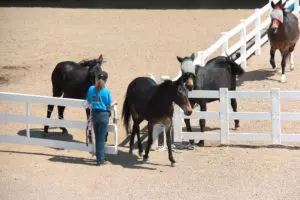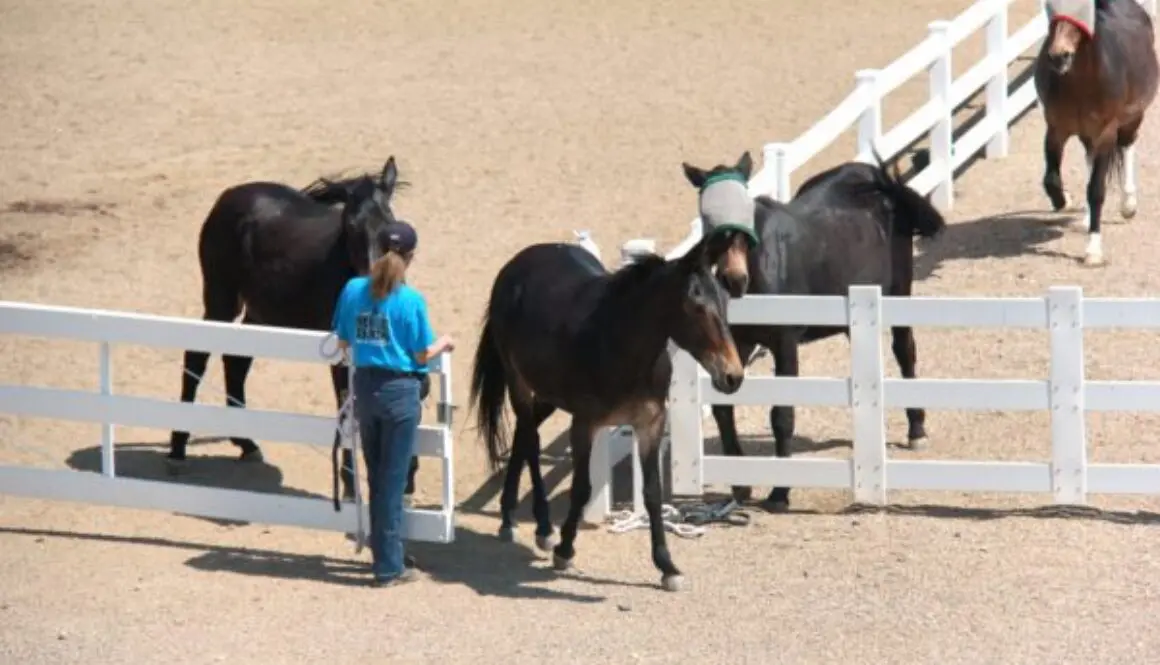MULE CROSSING: Gate Training
By Meredith Hodges
 Learning to go through a gate with respect and consideration for the handler is an important lesson for your equine to learn. Your considerate and consistent approach to retrieving him from his stall, pen or pasture can make all the difference in safety and pleasure for you both. This begins from the time you take him from his stall. Do not go into his area, but rather, ask him to come to you. If you have been consistent rewarding your equine from your fanny pack with the same oats he gets fed every evening, this should not pose a problem. The reason for feeding the oats in the evenings is so he is given the motivation to come back in during the spring months when pasture time must be limited. Feeding only grass hay in the morning gives him incentive to come to you to be haltered for lessons, as he knows his efforts will be rewarded with extra oats. Use verbal commands to “come on!” prefaced by his name. This reinforces his response to verbal commands and familiarity with his name. This will come in handy when you need to fetch him from a pen of multiple animals.
Learning to go through a gate with respect and consideration for the handler is an important lesson for your equine to learn. Your considerate and consistent approach to retrieving him from his stall, pen or pasture can make all the difference in safety and pleasure for you both. This begins from the time you take him from his stall. Do not go into his area, but rather, ask him to come to you. If you have been consistent rewarding your equine from your fanny pack with the same oats he gets fed every evening, this should not pose a problem. The reason for feeding the oats in the evenings is so he is given the motivation to come back in during the spring months when pasture time must be limited. Feeding only grass hay in the morning gives him incentive to come to you to be haltered for lessons, as he knows his efforts will be rewarded with extra oats. Use verbal commands to “come on!” prefaced by his name. This reinforces his response to verbal commands and familiarity with his name. This will come in handy when you need to fetch him from a pen of multiple animals.
 Going through a gate seems simple enough, but you can really get into trouble if it is not done correctly. Ask your mule to follow your shoulder to the gate and halt squarely, and then reward him (crimped oats) for standing quietly while you unlatch the gate. When going through the gate, if possible, the gate should always open away from you and your mule. When the gate is hinged on the left, transfer your lead line from your left hand (showmanship position) to your right hand, and open the gate with your left hand. Switch positions if the gate is hinged on the right, but always be sure to keep your body, rather than your mule’s body, closest to the gate. Ask your mule to walk through at your shoulder, to turn and face you on the other side of the gate, and to follow you as you close it. Then reward him again and latch the gate.
Going through a gate seems simple enough, but you can really get into trouble if it is not done correctly. Ask your mule to follow your shoulder to the gate and halt squarely, and then reward him (crimped oats) for standing quietly while you unlatch the gate. When going through the gate, if possible, the gate should always open away from you and your mule. When the gate is hinged on the left, transfer your lead line from your left hand (showmanship position) to your right hand, and open the gate with your left hand. Switch positions if the gate is hinged on the right, but always be sure to keep your body, rather than your mule’s body, closest to the gate. Ask your mule to walk through at your shoulder, to turn and face you on the other side of the gate, and to follow you as you close it. Then reward him again and latch the gate.
 After latching the gate, turn back to your mule and reward him yet again for being patient and standing still while you latched the gate. This repetitive behavior through gates will teach him to stay with you and wait patiently instead of charging through, or pulling away from you. This is especially helpful when you are leading several animals at once. This way, you can get through a gate safely with as many animals as you choose to lead through together. Even if the gate is only two mules wide, you could lead as many as four through by simply lengthening the lead lines of the back pair, asking the first pair to come through first then encouraging the second pair to come through directly behind them before you turn back to the gate. When trained this way, your mules will all line up like little soldiers on the other side of the gate to receive their rewards. They will stand quietly while you latch the gate and will only proceed from the gate when you ask.
After latching the gate, turn back to your mule and reward him yet again for being patient and standing still while you latched the gate. This repetitive behavior through gates will teach him to stay with you and wait patiently instead of charging through, or pulling away from you. This is especially helpful when you are leading several animals at once. This way, you can get through a gate safely with as many animals as you choose to lead through together. Even if the gate is only two mules wide, you could lead as many as four through by simply lengthening the lead lines of the back pair, asking the first pair to come through first then encouraging the second pair to come through directly behind them before you turn back to the gate. When trained this way, your mules will all line up like little soldiers on the other side of the gate to receive their rewards. They will stand quietly while you latch the gate and will only proceed from the gate when you ask.
 When you return your mule to a pen with other animals, wave the others away from the gate and return the mule to the pen the same way he was taken out. Lead your mule or mules through the gate, reward them, and then reward the others for staying back.
When you return your mule to a pen with other animals, wave the others away from the gate and return the mule to the pen the same way he was taken out. Lead your mule or mules through the gate, reward them, and then reward the others for staying back.
If you have any problems with kicking, carry a whip with you to keep the problem children at bay while you reward the others first. Do not vary this routine.
 The repetition will build good habits. Once the others have learned that they cannot approach when you wave them away, and each mule knows the routine of going through the gate properly, and you want to take one animal from the herd, you can call his name, wave the others away with your hand, open the gate and allow him to come through and turn (receiving his reward, of course) to put on the halter. You never have to get in the middle of their sometimes-dangerous playfulness again, and your animals will all be easy to catch.
The repetition will build good habits. Once the others have learned that they cannot approach when you wave them away, and each mule knows the routine of going through the gate properly, and you want to take one animal from the herd, you can call his name, wave the others away with your hand, open the gate and allow him to come through and turn (receiving his reward, of course) to put on the halter. You never have to get in the middle of their sometimes-dangerous playfulness again, and your animals will all be easy to catch.
To learn more about Meredith Hodges and her comprehensive all-breed equine training program, visit LuckyThreeRanch.com, MEREDITH HODGES PUBLIC FIGURE Facebook page, or call 1-800-816-7566. Check out her children’s website at JasperTheMule.com. Also, find Meredith on Pinterest, Instagram, MeWe, YouTube and Twitter.
Covered in TRAINING MULES & DONKEY: A LOGICAL APPROACH TO TRAINING, TRAINING WITHOUT RESISTANCE and EQUUS REVISITED at www.luckythreeranchstore.com.
© 2003, 2016, 2017, 2024 Lucky Three Ranch, Inc. All Rights Reserved.






















